France 3rd April - Blockhaus de l'Éperlecques
We had determined to see the Hitler WW2 bunker at Éperlecques on this trip. This lies in a forest near St Omer, not far from Calais.
Accordingly we stayed at a campsite nearby overnight. It had a British red telephone box as a feature, no doubt to make us all feel at home. The next morning I got up early as the dawn was peeking through the trees.
Accordingly we stayed at a campsite nearby overnight. It had a British red telephone box as a feature, no doubt to make us all feel at home. The next morning I got up early as the dawn was peeking through the trees.
We drove to the visitor centre as it was opening and there were few other people about. From there we walked through the woods, past ponds which may have marked shell holes, until the enormous hulk of the bunker came into view. It was designed by the Nazis and building commenced early in 1943 using thousands of prisoners of war and conscripted locals, living in conditions of slavery and working round the clock in 12 hour shifts. The construction was for the assembly and deployment of the V2 missile, Hitler's Wunderwaffe or wonder weapon which he thought would change the course of the war. The V2 had been designed in Peenemunde in Germany and Éperlecques could have held 100 missiles and fired up to 36 a day, aimed at London and the south east of England. The rocket fuel was LOX - cryogenic liquid oxygen and this had to be produced near the launch site as it evaporates very quickly.
In the spring of 1943 the work was noticed by an RAF reconnaissance mission. Although it was not understood at the time what was going on here the site was bombed in the August by US B-52s. The concrete was still setting, and the bombs caused great damage, killing large numbers of the workers, although they had tried to time the attack to coincide with their shift change. The Germans managed to save part of the building by building a 5m deep concrete slab on the ground and manouvering it up into place with hydraulic jacks to form a roof which they hoped would be impenetrable. As the bombardment made the site too risky for launching the V2 they hoped to use this space for the production of LOX for weapons to be produced at a different site, La Coupole at Wizernes, a few miles away.
During 1944 both Éperlecques and Wizernes were bombed repeatedly and finally a Tallboy, earthquake bomb was used at Éperlecques which brought it's use as a military establishment to an end. The crater where the bomb landed can be seen next to the building. The site was captured by Canadian troops in September 1944. The Germans had removed the pumps which drained the cellars so the bottom of the building had become flooded.
In 1945 the Americans used the bunker to test their Disney bomb. The results of the test were inconclusive and it was too close to the end of the war for this missile to make much difference.
The bunker itself is 92m wide and 28m high with walls up to 7m thick. The cellars go below ground for 6m. I found it a very impressive, very sad place. The sky was overcast when we visited and the surroundings of damp woodland added to the brooding atmosphere. We visited la Couple on the way home, and although there is much more to see and learn there it had none of the resonance of Éperlecques.
I took a large number of pictures here, a coloured set and a set converted to monochrome. I also had the infrared camera with me and used this a little. I will post the colour images here and then the others in a separate blog.We went inside the bunker where a film show was running about the V1 rocket, one of which is on the site with it's launcher. The last picture is of the crater formed by the Tallboy bomb. As we were leaving 3 coach loads of Italian tourists came in and the atmosphere changed.
That afternoon we drove south and stopped for the night at the Val de Vesle campsite just south of Rheims























Comments
Post a Comment